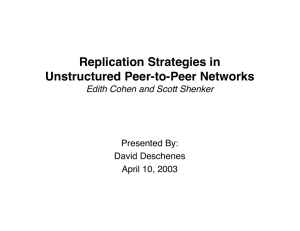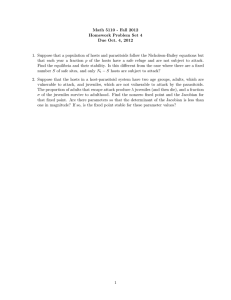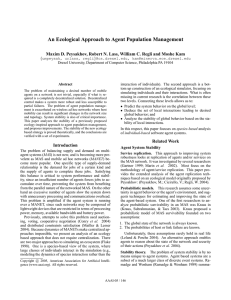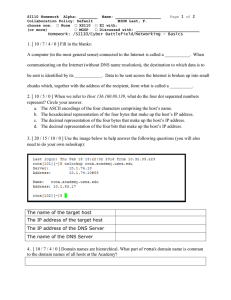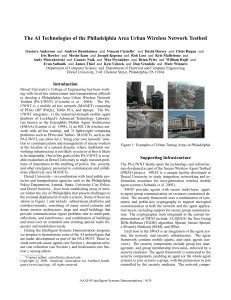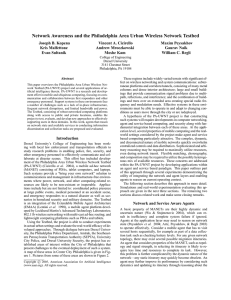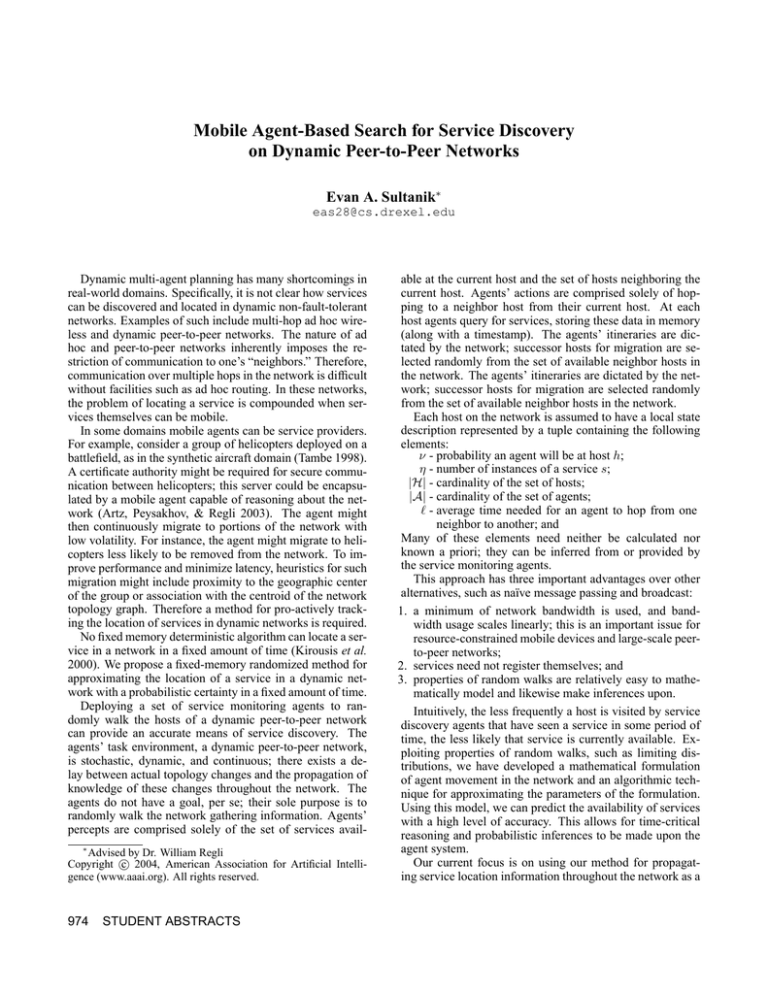
Mobile Agent-Based Search for Service Discovery
on Dynamic Peer-to-Peer Networks
Evan A. Sultanik∗
eas28@cs.drexel.edu
Dynamic multi-agent planning has many shortcomings in
real-world domains. Specifically, it is not clear how services
can be discovered and located in dynamic non-fault-tolerant
networks. Examples of such include multi-hop ad hoc wireless and dynamic peer-to-peer networks. The nature of ad
hoc and peer-to-peer networks inherently imposes the restriction of communication to one’s “neighbors.” Therefore,
communication over multiple hops in the network is difficult
without facilities such as ad hoc routing. In these networks,
the problem of locating a service is compounded when services themselves can be mobile.
In some domains mobile agents can be service providers.
For example, consider a group of helicopters deployed on a
battlefield, as in the synthetic aircraft domain (Tambe 1998).
A certificate authority might be required for secure communication between helicopters; this server could be encapsulated by a mobile agent capable of reasoning about the network (Artz, Peysakhov, & Regli 2003). The agent might
then continuously migrate to portions of the network with
low volatility. For instance, the agent might migrate to helicopters less likely to be removed from the network. To improve performance and minimize latency, heuristics for such
migration might include proximity to the geographic center
of the group or association with the centroid of the network
topology graph. Therefore a method for pro-actively tracking the location of services in dynamic networks is required.
No fixed memory deterministic algorithm can locate a service in a network in a fixed amount of time (Kirousis et al.
2000). We propose a fixed-memory randomized method for
approximating the location of a service in a dynamic network with a probabilistic certainty in a fixed amount of time.
Deploying a set of service monitoring agents to randomly walk the hosts of a dynamic peer-to-peer network
can provide an accurate means of service discovery. The
agents’ task environment, a dynamic peer-to-peer network,
is stochastic, dynamic, and continuous; there exists a delay between actual topology changes and the propagation of
knowledge of these changes throughout the network. The
agents do not have a goal, per se; their sole purpose is to
randomly walk the network gathering information. Agents’
percepts are comprised solely of the set of services avail∗
Advised by Dr. William Regli
c 2004, American Association for Artificial IntelliCopyright gence (www.aaai.org). All rights reserved.
974
STUDENT ABSTRACTS
able at the current host and the set of hosts neighboring the
current host. Agents’ actions are comprised solely of hopping to a neighbor host from their current host. At each
host agents query for services, storing these data in memory
(along with a timestamp). The agents’ itineraries are dictated by the network; successor hosts for migration are selected randomly from the set of available neighbor hosts in
the network. The agents’ itineraries are dictated by the network; successor hosts for migration are selected randomly
from the set of available neighbor hosts in the network.
Each host on the network is assumed to have a local state
description represented by a tuple containing the following
elements:
ν - probability an agent will be at host h;
η - number of instances of a service s;
|H| - cardinality of the set of hosts;
|A| - cardinality of the set of agents;
` - average time needed for an agent to hop from one
neighbor to another; and
Many of these elements need neither be calculated nor
known a priori; they can be inferred from or provided by
the service monitoring agents.
This approach has three important advantages over other
alternatives, such as naı̈ve message passing and broadcast:
1. a minimum of network bandwidth is used, and bandwidth usage scales linearly; this is an important issue for
resource-constrained mobile devices and large-scale peerto-peer networks;
2. services need not register themselves; and
3. properties of random walks are relatively easy to mathematically model and likewise make inferences upon.
Intuitively, the less frequently a host is visited by service
discovery agents that have seen a service in some period of
time, the less likely that service is currently available. Exploiting properties of random walks, such as limiting distributions, we have developed a mathematical formulation
of agent movement in the network and an algorithmic technique for approximating the parameters of the formulation.
Using this model, we can predict the availability of services
with a high level of accuracy. This allows for time-critical
reasoning and probabilistic inferences to be made upon the
agent system.
Our current focus is on using our method for propagating service location information throughout the network as a
heuristic for mobile agent-based search. For example, each
host could cache the data brought to them by the random
walking service discovery agents. In doing so, each host
would develop an index (or “belief”) of the locations of services. These beliefs will become more accurate in conjunction with a host’s proximity to the service. Therefore these
beliefs, along with the timestamp of when the agent last saw
the service, can be used as a hill climbing search heuristic
when tracking down the service.
Our current research is focusing on the feasibility, admissibility, and accuracy of this heuristic, and its integration
into the Secure Wireless Agent Testbed (SWAT) (Sultanik
et al. 2003). This includes live tests with a dozen resourceconstrained mobile computing devices, communicating over
an ad hoc wireless network.
References
Artz, D.; Peysakhov, M.; and Regli, W. 2003. Network
meta-reasoning for information assurance in mobile agent
systems. In Proceedings of the Eighteenth International
Joint Conference on Artificial Intelligence, 1455–57.
Kirousis, L. M.; Kranakis, E.; Krizanc, D.; and Stamatiou,
Y. C. 2000. Locating information with uncertainty in fully
interconnected networks. In International Symposium on
Distributed Computing, 283–296.
Sultanik, E.; Artz, D.; Anderson, G.; Kam, M.; Regli,
W.; Peysakhov, M.; Sevy, J.; Belov, N.; Morizio, N.; and
Mroczkowski, A. 2003. Secure mobile agents on ad hoc
wireless networks. In The Fifteenth Innovative Applications of Artificial Intelligence Conference. American Association for Artificial Intelligence.
Tambe, M. 1998. Implementing agent teams in dynamic
multi-agent environments. Applied Artificial Intelligence
12(2–3):189–210.
STUDENT ABSTRACTS 975


